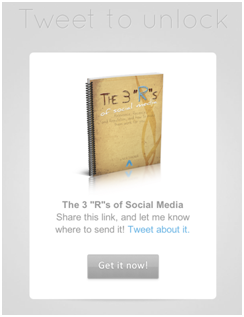This is a guest post by an old buddy named Nick Thacker.
Since I’m all about leverage and teaching yourself to work smarter (not harder) I thought this was a great fit for BGB readers. And since this blog is about biz and branding… well how could I resist?!
So cop a squat, whip out your granny glasses, and get to readin’. And when you’re done, be sure to drop a thought in the comment area below this post.
It’s kind of like dropping a quarter in the old tip jar… only you’re making Nick feel fabulously special and you’re sending a smoke signal to moi that lets me know you are indeed alive and kicking out there in the interweb ether.
As to why I need to know you’re alive and kicking… I just do dammit! Don’t judge!
Long ago, I got this idea in my mind that the surefire way to succeed in pretty much anything was by figuring out a way to “systemize” it. That may not always be the case, but I’ve realized that most of what I did as an entrepreneur could have been improved by learning to deploy systems.
In marketing—especially online—systems can be used to increase your ROI; you already know this. Most importantly though: systems and processes can give you the space and freedom to work on the things that matter the most to you.
Reading sites like Zen Habits, Lifehacker, and other minimalistic productivity sites led me to realize that my goal for my “systems” has more to do with wanting to create more personal space in my life than it does with the actual marketing. By having more personal space, I can focus on the things that truly matter: building stuff that will help more people, my family, and anything else I want.
Marketing systems are just processes you create, that are either self-sustaining or require little intervention. Once you set them up, they’ll take little tweaking—and this is even easier to do online when it comes to your social media plan.
In this post, I’ll talk about two specific areas for creating and deploying systems: In actual marketing streams (using social media), and in our daily lives.
First, here are some specific ways to create systems for your marketing channels:
Create a “self-marketing” landing page for your stuff.
As a test for this post, I set up a quick “Tweet to Unlock” system that allows people to download a free eBook if they’ll Tweet my message. This is a great example of leveraged-exponential growth—it starts with a few initial Tweets, and continues indefinitely throughout the network.
I don’t need to keep sending out email blasts, promotions, or other marketing shenanigans in order to create an ongoing lead pipeline.
I created this page using another template and some ninja-hacking skillz, but Glen over at ViperChill.com has created a FREE version of this you can get here.
Use a sweet plethora of free social apps.
I love to duct-tape things together like MacGyver (probably my ghetto upbringing), and my social media marketing is no different.
- Use Ifttt.com to create “tasks” and “recipes” that will post automatically to your Facebook page, Twitter account, and more, depending on which tags or categories you use.
- Use Buffer, Ifttt.com, and ReadItLater (or Instapaper) to send scheduled updates to your networks whenever you read something with specific tags.
- Use Engag.io to keep tabs on your network conversations. It can organize all of your Twitter, Facebook, Google+, and Gmail conversations (and more!) all in one place.
Let’s look at some ways to leverage your own time and effort, and create space for other things.
Recognize your own strengths.
You know where you get your best work done, and you probably already know what time of the day/week works best for you.
Start using systems in your day-to-day life to get more done. I wrote a series of posts on “sleep-hacking” that explains how to sleep fewer hours, yet still end up refreshed, more productive, and with more time for your own stuff.
And right here on BigGirlBranding.com there are plenty of great posts about getting more done with, more space for you left over.
The best way to create more space for yourself is simple:
You must plan it.
People ask me all the time how I have so much time to do all of the things I do. My response—without fail—is, “I make time. Nobody has free time.”
This, I’m guessing, describes you. You don’t have free time. You don’t waste precious hours of the day on daydreaming. But somehow you’re just not getting it all done. There’s a disconnect happening, and it’s not something you’re excited about.
So to combat this, you must plan time to give yourself space. This can be any kind of space—space to sit and do nothing, space to organize, space to run through an open meadow, whatever. And to create space, all you need to do is figure out your real working schedule.
I use tools to help me track my time, plan my tasks, and basically get as much as possible out of my effort. The result? You guessed it—more space for me! Here are some of the things I’ve found to work best:
- The Pomodoro Technique. Basically, you’re giving yourself a block of time to work, and a smaller block of time to do anything but work. There are a lot of great apps out there that can help, but you really only need a timer and some time.
- Write everything down. I use Wunderlist and Evernote, and Scrivener for my books. I was never into pencil-and-paper planning tools, but if you’re a write-it-down-er, go for it. The goal is to get everything out of your head and into a system.
- Pareto’s Principle. Chances are, 80% of your results in work, life, and everything in-between are caused by only 20% of the effort. As shocking as this is, I’ve found it to be generally true for myself. Think about it: 30% of our entire life is spent sleeping—that leaves only 60% of every 24-hour period!
Again, the best results I’ve found in work and life have come from strategically planning my time. You don’t inherently have time to work out, blog, run a business, talk walks, take naps, go to the movies, or read books—but you probably try to do all of these things anyway.
As marketers and business owners, you need to work on using systems in two major areas: Obviously, your marketing, especially through social media, can be improved from a few processes and systems you set in place. The other systems that will provide the most benefit to you and your business are the ones you put in place in your own life.
Whatever your role—be it business owner, blogger, marketing director, or all of the above—put systems into place that will allow you the freedom to create bigger and better things. If you need help, I happen to know a girl who’s pretty good with things like that!
Alrighty. Listen up you. Yeah YOU! If you liked this post, found it insanely useful, and are madly in love with Nick now, please submit to your compulsion to share it with your pals. See those buttons off to the left? Yep, those are the ones. Share, share, share away! 😉


